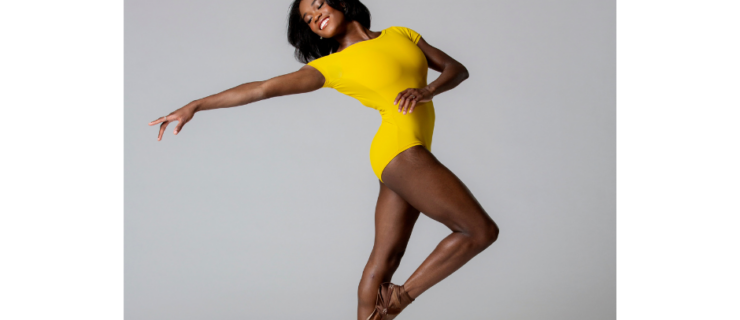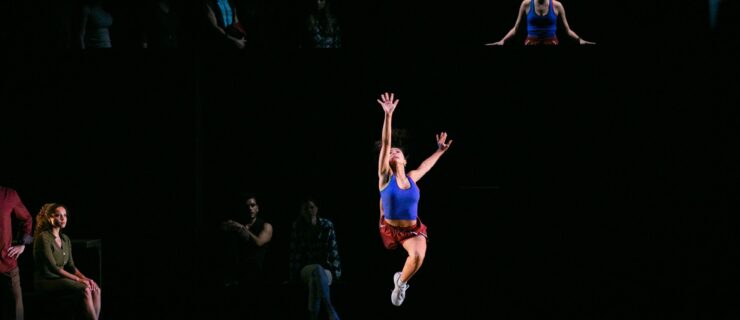Athletic Trainer Megan Richardson
Ballet Hispanico dancer Jessica Batten had never experienced an acute injury—until last May. Jessica was performing a petit allegro combination in company class when she slipped and suffered a lateral ankle sprain.
She sought immediate help, calling Megan Richardson, an athletic trainer at Harkness Center for Dance Injuries and PT Plus, both in NYC. “Megan was my hero that day because she came to Ballet Hispanico right away, checked me out and diagnosed me with my sprain,” Jessica says. After two weeks of steady rehabilitation and therapy, Jessica was ready to step back onstage.
Jessica is just one of many dancers who have benefited from Megan’s rehabilitation services in the greater NYC area. (Megan has also worked as a fitness consultant for DS! You can see exercises she’s recommended in March and April 2008.) Here, this busy athletic trainer talks about how having been a dancer prepared her to help heal her peers.
From Dance to Science
Originally from Amityville, NY, Megan danced at a local studio, studying ballet, jazz and lyrical. As a teen, she split her time between her local high school and a cultural arts high school on Long Island, where dance education counted toward her academic credits. Megan danced four hours a day, learning Graham and Horton techniques as well as African dance and tap. In high school, she became interested in sports medicine, but wanted to apply it to dance. She remembers thinking, “I could take what I was learning about athletes and tweak it to fit the dancer’s needs.”
She attended George Washington University in Washington, DC, taking a full dance and academic load. She maintained a high level of dance training and performance throughout her college career—even dancing in a piece commissioned by and performed at The Kennedy Center. Megan graduated with a bachelor’s degree in exercise science and athletic training (she was three credits shy of completing her dance major, due to a schedule conflict with a required dance course).
Megan went on to earn a master’s degree in kinesiology and athletic training from Indiana University. She kept researching ways to specialize in dance injuries and rehabilitation by attending conferences and joining the International Association for Dance Medicine and Science (iadms.org), where she now serves as a chair member. After graduating from IU, Megan volunteered to shadow Harkness Center for Dance Injuries athletic trainer Marijeanne Liederbach for the summer at the American Dance Festival. At ADF, Megan assisted Marijeanne and offered rehabilitation services to dancers.
At the end of that summer, Marijeanne invited Megan to interview for an open research assistant position at Harkness. “My goal was always that athletic training and dance medicine would be my fallback after I did about five years of dance,” Megan says, “but I thought, ‘I can pass up the [Harkness] opportunity and maybe not get it again, or I can take it.’” In October 2001, she joined HCDI’s staff of doctors and certified athletic trainers. Though she still takes dance class from time to time, she explains, “I had to shift gears totally.”
What is an Athletic Trainer?
Athletic trainers are often confused with physical therapists. “Athletic trainers are specifically educated to work with the musculoskeletal system and the athletic population,” Megan explains. Physical therapists’ training goes beyond the musculoskeletal system, preparing them to work with a variety of populations including stroke victims, burn victims, geriatrics and cerebral palsy patients.
The Harkness Center for Dance Injuries at the NYU Hospital for Joint Diseases is dedicated to providing musculoskeletal health care to dancers who are either uninsured or underinsured. HCDI assists the dance community in injury prevention, reduction and rehabilitation. It also has contracts with dance companies and organizations including Ballet Hispanico and SUNY Purchase Conservatory of Dance, to which Megan travels to provide therapy to dancers.
Megan also works part-time at PT Plus, a physical therapy clinic in the New York City Center building where companies like Alvin Ailey American Dance Theater and American Ballet Theatre regularly perform. PT Plus is contracted with several Broadway shows, including Wicked, where Megan and her colleagues provide backstage coverage. Megan also offers private Pilates sessions at PT Plus.
So what kind of injuries does she treat most often? “With dance in general, research has shown that about 65 percent of injuries are from overuse,” Megan says. “You have repetitive strain on particular tissues. So we see a lot of tendonitis and stress fractures. It’s wear and tear, and eventually something gets inflamed or irritated.”
Megan also assists patients who have suffered acute injuries, such as lateral ankle sprains or broken bones. In Jessica’s case, Megan’s rehabilitation work included Thera-band exercises, pliés and relevés at the barre, range of motion exercises, and a plié arabesque passé sequence on a trampoline. Jessica saw Megan twice a week for the first three weeks after her injury, then dropped down to once a week.
New York Knicks City Dancer Erika Gee suffered from a string of lateral ankle sprains and even broke bones in her right foot. Since Erika began dancing with the KCD in September 2007, she’s experienced two more ankle sprains and knee irritation. Her primary sports medicine doctor put her in touch with Megan at PT Plus. “I went in thinking I needed to work on my right ankle, but it was really a lot of weakness in my right hip,” Erika says. “Megan attacked the ankle thing from all angles.”
During her two months of therapy with Megan, Erika explains, “We strengthened the whole hip, the whole leg and the whole foot.” Erika learned a repertoire of challenging exercises that she can take on the road and do with just a Thera-band or a towel. “Training with Megan, being that she’s a dancer—it changes the experience,” Erika says. “It makes it more worthwhile, and it moves it along quicker.”
Understanding Dancers
“I see dancers as a very specialized population of artist and athlete, and they need to keep their instrument—the body—very highly tuned,” Megan says. “I like the challenge of not only helping them get through an injury, but also to get back to an extreme level of fitness and ability.”
But training dancers goes beyond their physical needs. “You have to know the psyche of a dancer,” Megan adds. “Dance is competitive, and you’re replaceable. So you have to understand that if you tell a dancer that they can’t do something, or that they have to stop altogether, then that might mean they don’t get a job or they can’t pay their rent. It’s very important to understand the lifestyle of a dancer, and it helps if you were a dancer yourself. You have that organic knowledge.”
For Megan, the most rewarding part of her job is “giving dancers a service that is absolutely needed in their lifestyle. They’re elite athletes. Dancers need to be educated to know how to take care of their body correctly, and to rehab it well when they’re injured.” She adds, “I want dancers to have people around them who have the knowledge and understanding of what they do to be able to support them in their art. I’m intrigued by the amazing abilities of the body, both in movement and in healing, so it’s a natural fit for me to work with dancers in the capacity I do.”
Allison Duke, a graduate from the University of Utah’s Department of Ballet, is a New Hampshire–based dancer, teacher and writer. She also contributes to
Pointe magazine.



